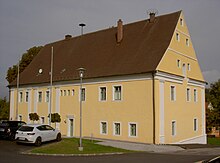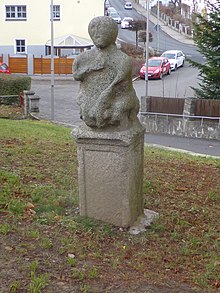Maintenance lock raft
The Pflegschloss raft was in the 17th century under the Dukes of Pfalz-Sulzbach in raft built. It was originally planned as a secondary residence for the dukes, but was used as the seat of the raft keeper , as a toe box and as a forest office apartment. In the 20th century the town hall of Floß was housed here.
history
The nursing home was built from 1671 to 1673 by master builder Giovanni Rampino von Bärnau for Count Palatine Christian August von Sulzbach as a “princely new building”. The purchase proceeds from the sale of “Mayerey Münchshof” were used for financing. The court chamber councilor of the Palatinate government in Sulzbach, Johann Heinrich Seyfried , was the government commissioner for the construction. The new building was built on the so-called Brunnquell. When the Count Palatine comes to inspect the building, he has to pay beer and bread for the workers. In 1719 Scharwerk was ordered to build a palisade fence around the maintenance lock , as it was located quite outside the market. In 1729 there is again talk of the “palletizing” of the princely building at Floß. Instead of the palisades, a wall was built in 1758/59, but in 1773 it was already brittle and in need of renovation.
The new building did not find the use it was originally intended for, namely as an outdoor seat for the Duke of Sulzbach. In 1780/82 there is talk of the lease of the “lordly box house” to Carl Joseph Gemmingen von Maßenbach zu Altenstadt . At that time, the “trydt box” was in the attic of the “new building”. Herr von Gemmingen should not interfere in the Floss forestry office account and also the electoral officials “ Titl. von Hözendorff in no way offending ”. However, there were disagreements because of a wooden outbuilding, Jacob Franz von Hözendorff had a Saliter plantation here and the von Gemmingen wanted to store his equipment here. How the dispute ended is not reported, but an inventory of August 11, 1784 mentions the forest office apartment with a grain box; this included a cattle house, a wooden shed, a beer cellar, a potato vault and an old saltpeter plantation, "which, however, was almost entirely closed". From 1789 to 1791 an extension was built on the new nursing home; Franz von Hözendorf continued to be the carer .
Due to the ordinance of March 24, 1802, Floß lost all of his offices and in 1803 the time ended when the Floß nursing office was located here. In 1807 the building came to two protective Jews and from these to the innkeeper Schopper . From his heirs it came to the market town of Floß in 1859. From 1922/23 to 1974 the town hall of the town of Floß was housed here.
building
The two-story house has a high pitched roof . The structure is adorned with a colossal structure of pilasters .
At the house there is a granite figure of a seated man, the so-called Bäumannchen (popularly s' Baimannl ); it is a gnome-like figure with long arms, with the right hand close to the heart as a gesture of humility. It probably dates from the Romanesque period. It used to stand on the enclosure wall of the care lock, in 1975 it was given a place at the pedestrian staircase between the care lock and the town hall.
literature
- Adolf Wolfgang Schuster : 100 years of raft. For the local festival of the Floß market in the Upper Palatinate Forest. Marktgemeinde Floß, Floß 1976, pp. 233-236, 267.
Web links
Individual evidence
- ^ Adolf Wolfgang Schuster, 1976, p. 389.
Coordinates: 49 ° 43 ′ 20.7 " N , 12 ° 16 ′ 48.3" E


